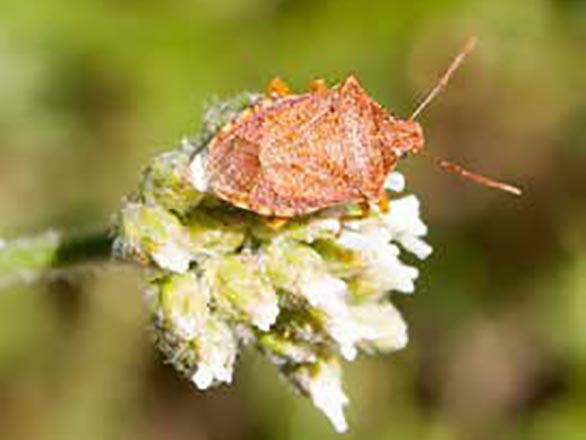 Scientific name: Chlorochroa spp. (shield bug) Halyomorpha halys (brown marmorated stink bug)
Scientific name: Chlorochroa spp. (shield bug) Halyomorpha halys (brown marmorated stink bug)
Order: Hemiptera
Description: Shield bugs (sometimes called stink bugs) are winged, somewhat triangular insects, about a half inch long. Immature bugs (nymphs) resemble the adults but are wingless. Shield bugs are green, with various colors around the edge of the abdomen. Brown marmorated stink bug (BMSB) is medium- to dark-brown, with two white bands on the antennae and white and dark spots along the edges of the abdomen. Adults are winged with a “V” shape on their abdomen. Some species of shield bug (such as species of Podisus) eat other insects and can be beneficial in the garden, while others are pests; correct identification is important.
Behavior: Plant-feeding shield bugs stick their piercing-sucking mouthparts into plant stems or fruit. They disperse quickly when disturbed. Predatory shield bugs use their mouthparts to feed on other insects and arthropods. Shield bugs release a foul odor when disturbed.
Life cycle: Shield bugs spend the winter as adults and lay drum-shaped eggs on plant leaves in the spring. After egg hatch, the nymphs feed for approximately six weeks before molting into mature, winged adults.
Diet and damage: Shield bugs have a variety of hosts. They are rarely pests of the crops in our area. Susceptible crops include berries; soft fruits such as tomatoes, peppers and peaches; and some nuts. Late-summer damage includes fruit discoloration, irregular fruit shape or shallow pits, and diseased or damaged fruit.
Monitoring: Monitor for shield bugs beginning in early summer. Pheromone traps are available for some shield bug species to monitor for population increase. In home gardens, a small amount of damage is not sufficient to warrant chemical treatments.
Control methods:
Cultural control: Removing weedy groundcovers can reduce the abundance of nearby individuals.
Mechanical control: Regular hand-removal of eggs or vacuuming of nymphs and adults are effective ways to control damage in home garden situations.
Biological control: A variety of invertebrates may feed on shield bug eggs and nymphs, including spiders, katydids and crickets, predatory beetles, earwigs, and parasitic flies and wasps.
Chemical control: A variety of organic and synthetic chemicals can be applied to control shield bugs. Some products, such as dormant oils, are applied when trees are dormant. Their use may help prevent damage to nontarget insects, including beneficial insects.
When applying any pesticide, read the entire product label thoroughly before application. If you see a Bee Advisory Box, this newly developed EPA label denotes a potentially high risk to bees and other pollinators.


